39 Best E-Learning Statistics for 2023
The Ultimate List of Online Learning Stats and Facts

The digital age and the expansion of the internet have led to a virtual revolution. One result of this revolution has been a digital transformation in every industry, and there are cloud-based services and post-social media channels all over the digital business realm.
All of these elements led to the inevitable rise of e-learning in the education industry. Convention centers and classrooms are no longer the only venues where people seeking knowledge can gain new insights and learning experiences.
Both individuals and companies are increasingly relying on a wide range of intuitive learning management systems. They can use various e-learning software tools, such as virtual education hubs, to access any desired content with nothing more than an internet connection and a smart device. These systems and tools make online learning more convenient, efficient, and user-centric.
E-learning can help you to achieve your goals if you’re a remote entrepreneur planning to launch a private online business class. They can also be helpful if you’re a business owner looking for the most straightforward, affordable, and effective way to deploy an enterprise-level training program for employees.
Let’s examine some of the most notable e-learning statistics for 2021 and beyond.
Top 10 E-Learning Statistics
- The e-learning industry has been around for 13 years now.
- It is expected to grow to $374.3 billion in the next four years.
- The latest massive open online course community has already gathered more than 100 million members.
- In 2020, e-learning demand had achieved 400% growth and was expected to grow at a similar rate in the next two years.
- 90% of businesses relied on e-learning software to provide training in 2020.
- Since 2000, the e-learning market has achieved growth of 900%.
- 40% of millennials prefer e-learning methods for developing more skills.
- E-learning can help to reduce energy consumption by 90%.
- More than 80% of all online activity is watching training or educational video content.
- Europe and the US collectively account for 70% of the global online learning market.
Overview of the most essential e-learning industry growth statistics
Let’s review some of the most significant online learning industry growth facts and figures.
1. The virtual learning industry has achieved tremendous 900% growth in the last 22 years.
Since 2000, the e-learning industry has grown by 900%. The internet is the leading cause of this global expansion of the digital learning industry. The newest studies indicate that the industry is expected to continue growing at a steady pace.
(Source: Assets.kpmg)
2. The global digital learning market is expected to reach over $243 billion by 2022.
According to the latest forecasts, the global online learning market will exceed the $243 billion mark in 2022.
(Source: Statista.com)
3. By 2026, the MOOC industry is forecast to reach $374 billion.
The massive open online course industry (MOOC) is currently rising. According to the latest reports, this industry will be worth $374 billion by 2026.
(Source: Globenewswire.com)
4. Demand for e-learning systems and software tools rose by almost 400% during the COVID-19 pandemic.
The coronavirus outbreak has significantly expedited the adoption of digital and IoT technologies, as well as prompted exponential growth in the virtual learning industry.
The demand for e-learning tools and systems rose by almost 400% during the pandemic. More than 40% of millennials use e-learning as their go-to solution for building more skills during their time off work.
(Source: Gminsights.com)
5. The virtual learning market is now 22 years old.
The term e-learning was coined the same year that Google was founded. Today, the modern digital learning industry is 22 years old and counting.
(Source: Shiftelearning.com)
Top statistics regarding the power of e-learning
The most significant benefit of e-learning is that it allows any internet user to learn online at their own pace and convenience. In addition, it makes a wide variety of content available to everyone with an internet connection. Internet users can choose how they want to interact with the e-learning content in any communication channel that they prefer.
Students can watch educational and training videos, read instructions via social media, email, or text, learn on the go, and tap into any content they prefer to achieve their learning goals. The power of online and mobile learning is immeasurable.
Let’s turn to facts and figures to understand the impact of e-learning in 2021 and beyond.
6. E-learning can help to save 40%-60% of employee time compared to more traditional learning methods.
Brandon-Hall’s research indicated that modern e-learning methods could help save up to 60% of employee time compared to a traditional learning setting. Since students can pick up knowledge at their own pace, this e-learning method requires 40%-60% less employee time.
(Source: Shiftelearning.com)
7. When compared to traditional learning methods, digital learning can increase consumer retention rates by 25-65%.
Compared with traditional learning methods, digital and mobile learning yield much better consumer retention rates. Face-to-face learning retention rates range from 8-10%, while e-learning training retention rates range from 25-65%.
(Source: Shiftelearning.com)
8. E-learning allows students to save time spent on training while learning a minimum of five times more material.
Participants using various digital and virtual learning methods managed to learn at least five times more information compared to students who used traditional learning methods. Additionally, e-learning allowed participants to save time by learning more over a shorter period.
(Source: Shiftelearning.com)
9. 42% of business organizations state that using e-learning training methods can help to increase revenue.
The latest statistics indicate that e-learning can help modern enterprises to increase customer retention rates and revenue. According to the studies, 42% of companies claim that e-learning solutions have helped them increase revenue.
(Source: Shiftelearning.com)
10. Companies that invest heavily in e-learning employee training see an ROI increase of $30 per employee.
A recent IBM research report showed that businesses could achieve a significant increase in productivity and revenue by investing in online training. For every dollar they spend on e-training, companies receive a $30 increase in revenue.
(Source: Shiftelearning.com)
11. E-learning methods can increase employee engagement by up to 18%.
E-learning technology and tools allow modern businesses to train their workforce efficiently and significantly boost employee productivity and engagement. According to a recent study by the Molly Fletcher Company, e-learning training can help companies to increase employee engagement by up to 18%.
(Source: Shiftelearning.com)
General overview of top e-learning financial statistics
According to numerous modern companies, saving resources is one of the fundamental e-learning benefits for businesses. This is the biggest reason why many organizations use e-training methods to their advantage. Aside from allowing employees to pick up information in their preferred way, e-training isn’t only more efficient – it’s cost-effective.
Companies can save money by providing better training to their employees. They can use the savings to impact their consumers and provide better products and services, customer support, and experience at every step of the customer journey.
Let’s list some of the most notable financial e-learning statistics to see how companies benefit from modern-day training methods.
12. IBM managed to save almost $200 million by making a shift to e-training.
Businesses can save a lot of money by switching to e-training. According to Dave Evans, IBM is an excellent example of how e-learning can benefit a business with cost-effectiveness. He reported that IBM saved up to $200 million by introducing e-learning methods in their employee training strategies. E-training allows companies to save resources on paying instructors, equipment, hotel rentals, travel, and more.
(Source: Shiftelearning.com)
13. Shifting to e-training allowed 42% of businesses to boost revenue.
According to a 2017 survey, e-training methods helped companies to convert information into revenue. 42% of surveyed businesses reported an increase in revenue after switching to e-learning methods.
(Source: Shiftelearning.com)
14. Cost of creating an online course ranges between $144 and $10,800.
According to Sell Courses Online’s article on e-learning, creating an online course can cost a business anywhere from $144 to $10,800, depending on the certification and the number of modules the online course provides.
(Source: Sellcoursesonline.com)
15. Online course fees range from $177 to $10,000, on average.
An array of online course offerings require little to no maintenance. That alone is enough reason for businesses to use e-training to ensure good ROI. On average, the price of an online course can be anywhere from $177 to $10,000.
(Source: Sellcoursesonline.com)
16. E-learning can help students and schools to get the most out of class studies, including language learning.
The language barrier is still one of the most prominent outsourcing and student exchange challenges. Thankfully, e-learning can help to overcome this barrier and open new learning and business opportunities globally. Because of this, the latest projections indicate that the global e-learning market is set to surpass $243 billion in 2022.

(Source: Statista.com)
Top academic e-learning insights and statistics
E-learning has taken the modern academic world by storm and quickly revolutionized the way students and academics receive information and progress in their learning. Let’s examine some of the top academic e-learning statistics for 2021 and beyond.
17. 75% of schools made plans to adopt e-learning methods by the end of 2021.
Currently, more than 57% of students in the US are already using or plan to start using a digital learning tool. Because of this, 75% of schools are already online or are making plans to complete their digital transformation process.
(Source: Thinkimpact.com)
18. Almost 100% of educational institutions switched their learning sessions to either an online or a mobile setting.
If we look at the top e-learning stats today, we can see that 80% of learning institutions have already purchased or are planning to purchase e-learning equipment. 98% of institutions have already been providing online classes for the past two years.
(Source: Thinkimpact.com)
19. 63% of high-school K-12 students use digital technologies to learn every day.
According to the latest studies, digital learning tools help most students learn every day. The statistics on digital learning tool usage show that 45% of elementary students, 64% of middle-school students, and 63% of high-school students use digital tools daily.
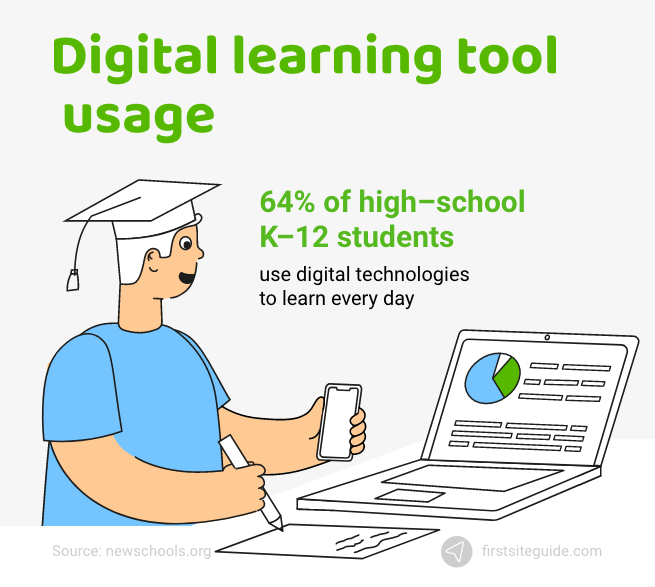
(Source: Newschools.org)
20. A 2016 survey showed that 43% of students used digital learning tools to help with homework and studying.
Digital learning technologies, tools, and methods are beneficial to modern students, especially when it comes to doing homework, studying, and coping with busy learning schedules. According to a survey from 2016, 43% of students found digital learning technologies helpful for completing their obligations.
(Source: Statista.com)
21. 81% of surveyed students reported that the regular use of e-learning tools could help to improve grades.
Since e-learning and digital tools allow students to access important information anytime and anywhere, they can help students to improve their grades. 81% of modern-day students said that digital learning helps them do better in school.
(Source: Statista.com)
22. A survey from April 2021 showed that 73% of surveyed students prefer online academic courses.
Out of 73% surveyed students who expressed their preference for taking online academic courses, 46% of students strongly agreed on taking all of their academic studies in a digital format, while 27% somewhat agreed.
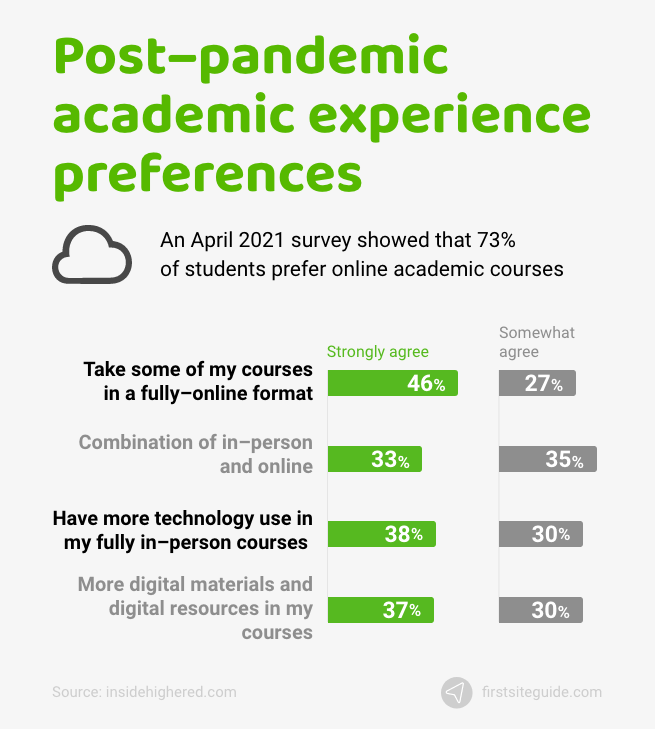
(Source: Insidehighered.com)
23. 41% of students prefer digital learning experiences over traditional ones.
E-learning is a preferred learning method among modern students simply because it provides them with personalized learning experiences. Recent studies showed that 41% of students preferred e-learning methods over traditional ones due to better user experience.
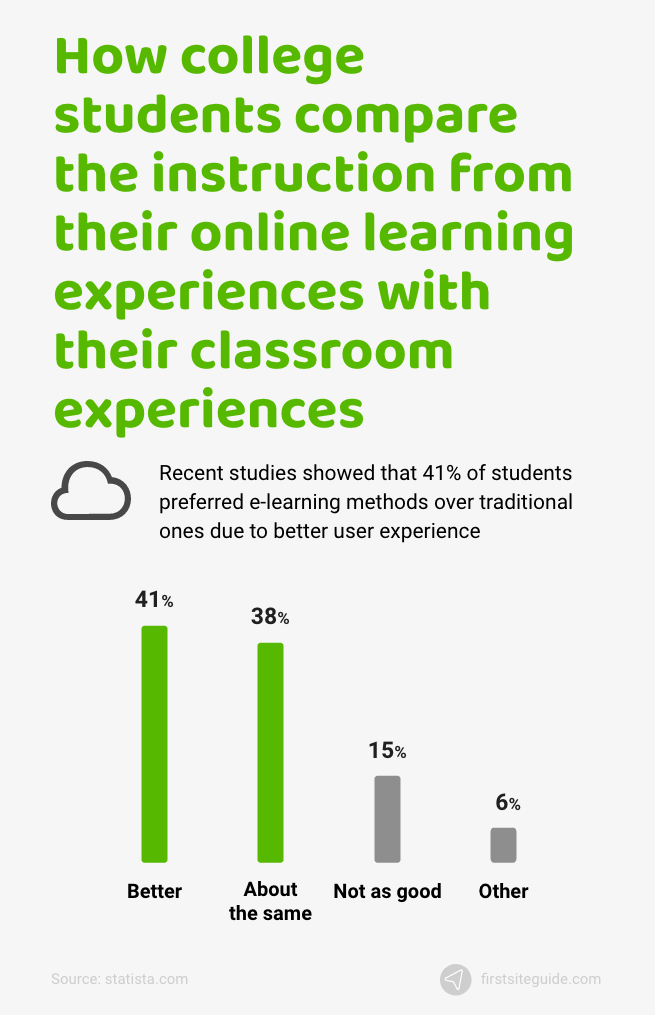
(Source: Statista.com)
24. Between September 2020 and February 2021, the percentage of K-12 schools that used hybrid learning methods went from 18.2% to 24.8%.
Since September 2020, the percentage of learning institutions, such as K-12 schools, that use hybrid teaching technologies has increased by 6.6%. By February 2021, the percentage of K-12 schools that used hybrid learning methods rose from 18.2% to 24.8%.
(Source: Statista.com)
25. In 2020, 25% of online US students surveyed were generally concerned with balancing education with everyday life.
According to a 2020 survey, 25% of former, prospective, and current online students were concerned with balancing their household, family, and work obligations with education. 15% of surveyed prospects expressed their concerns regarding academic support and online instruction quality.
(Source: Statista.com)
26. 96% of K-12 students use e-learning technologies because they are helpful, user-friendly, and fun.
According to a 2019 survey, 96% of elementary students, 65% of middle-school students, and 59% of high-school students used digital learning tools because they are fun. 71% of high-school students said e-learning tools helped them to learn at their own pace, while 51% expressed a desire to see e-learning technologies used more often at school.
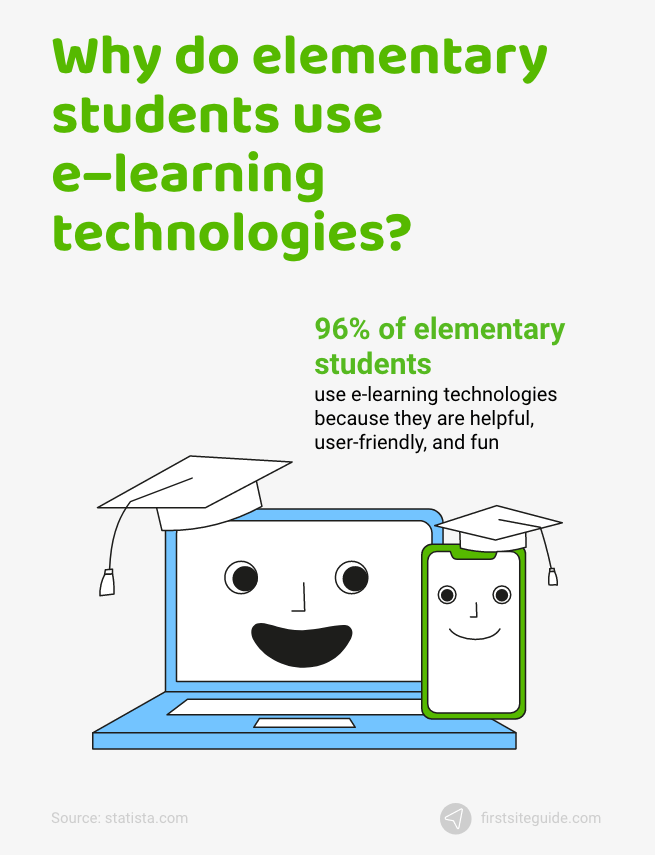
(Source: Statista.com)
27. The COVID-19 pandemic caused that number of children with reading difficulties to rise by 20%, reaching 584 million.
A study by UNESCO raised some significant concerns regarding children with reading difficulties. In 2019, there were 483 million children with reading difficulties. However, the COVID-19 pandemic caused that number to rise by 20%, reaching 584 million.

(Source: Statista.com)
28. Compared to traditional classroom learning, e-learning can save up to 60% time for students.
Students can save up to 60% more time by switching from traditional learning to e-studying.
(Source: Papersowl.com)
Top e-learning statistics from the corporate world
Digital technologies and the expansion of the internet have revolutionized the way that people teach, learn, and work. Training sessions for employees no longer have to be conducted in the classroom, and modern employees and business people have access to educational content anytime and anywhere.
Business mentors and coaches have a wide range of digital tools for distributing training and educational content in various methods. Whether we’re talking about online courses, virtual learning systems, or professional training on mobile devices, digital businesses reap many benefits from e-learning. Here are the top corporate e-learning stats to back this up.
29. Personalized and comprehensive corporate e-training sessions provide 24% higher profit margins and 218% higher revenue per trainee.
According to a survey that included 2,500 business organizations, businesses that used e-learning technologies for developing employee training programs achieved 24% higher profit margins and 218% higher revenue per employee trained.
(Source: Elearninginfographics.com)
30. 90% of business organizations offer e-learning and e-training options to employees.
According to LinkedIn’s report from 2018, 90% of enterprises provide their workforce with digital learning and e-training opportunities.
(Source: Learning.linkedin.com)
31. By 2026, the corporate segment of the digital learning industry is forecast to reach $50 billion.
According to the latest reports, the e-learning industry is constantly growing, achieving growth of 15% each year. Corporate adoption of digital learning is driving the industry’s growth. The industry’s projected worth is estimated to reach $50 billion by 2026.
(Source: Businesswire.com)
32. 82% of business organizations used a digital learning method to deliver a portion of their compliance training in 2018.
Study reports from 2018 indicated that 82% of corporations used various e-learning tools to provide employees with a portion of their compliance training. Most businesses used online learning to deliver specific compliance training modules, while 28% of enterprises relied on digital learning to deliver all of their compliance training.
(Source: Rainingmag.com)
33. Digital learning is the most effective way to bridge the skills gap, according to 62% of surveyed companies.
E-learning can help companies increase employee satisfaction, improve engagement, drive business growth, and bridge employee skills and knowledge gaps. 62% of companies reported that digital learning helped their employees to close the skills gap.
(Source: Blog.udemy.com)
34. 57% of employees reported that they are satisfied with their company’s training and development programs.
A recent study indicated that 57% of employees are quite satisfied with their companies’ latest digital learning and development programs.
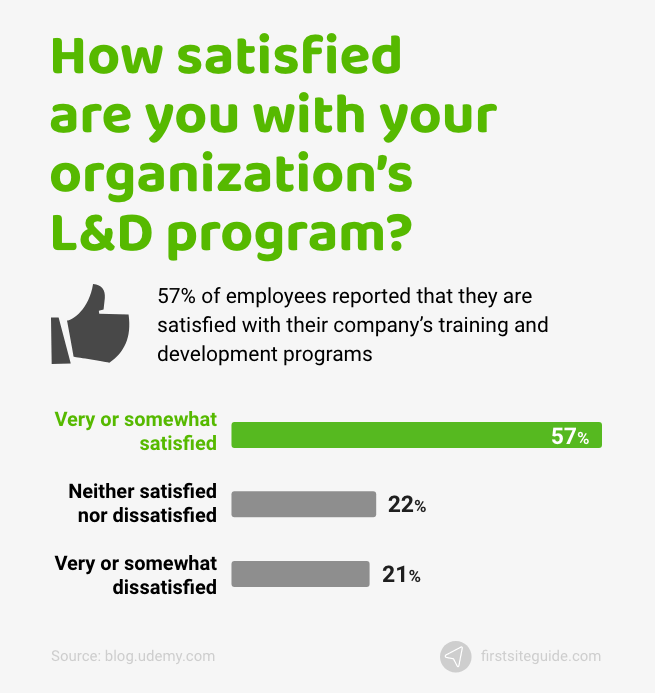
(Source: Blog.udemy.com)
35. Almost 42% of Fortune 500 companies use digital learning tools to train employees.
Digital learning technologies can be valuable assets for modern organizations, especially when it comes to training employees. Recent research showed that 41.7% of Fortune 500 business organizations provide training to their employees using digital learning tools.
(Source: Skilldynamics.com)
Most relevant global digital learning trends and statistics
Since digital learning technology offers such massive potential for the modern corporate realm, let’s look at some of the most relevant global e-learning stats.
36. Germany’s digital learning market achieves 8.5% growth annually.
Germany is the European digital learning market leader with the highest market share in Europe. The country’s online learning market grows steadily by 8.5% per year.
(Source: Businesswire.com)
37. The fastest-growing online learning market is the Asia Pacific, with a 17.3% growth rate.
According to the latest reports, e-learning is growing steadily worldwide, achieving a 7.6% global growth rate. The fastest-growing market segment is the Asia Pacific region (17.3%), followed by Eastern Europe (16.9%), Africa (15.2%), and Latin America (14.6%).
(Source: Docebo.com)
38. China’s K-12 e-learning market has grown by 20% since 2017.
The K-12 digital learning industry in China is vast and constantly growing. According to the latest studies, China’s K-12 e-learning market is growing steadily, achieving 20% growth since 2017.
(Source: Marketresearch.com)
39. 23.15 million US households with underaged children used e-learning to receive educational materials in 2021.
The COVID-19 pandemic caused all activities to cease for many US schools, leaving 181,300 households without the means to participate in education. As of April 2021, 23.15 million US households with underage children (under 18) used digital or virtual learning technologies to keep up with educational needs.
(Source: Statista.com)
Conclusion
These are the latest, most relevant e-learning statistics, trends, and facts that you need to know. These statistics help us to understand the importance of the digital learning industry and market and tell us how fast it’s growing, its impact on the current trends in the global business segment, and so much more.

Thanks for sharing the most relevant e-learning statistics, trends, and facts, it’s very useful information.
You’re welcome. Enjoy!